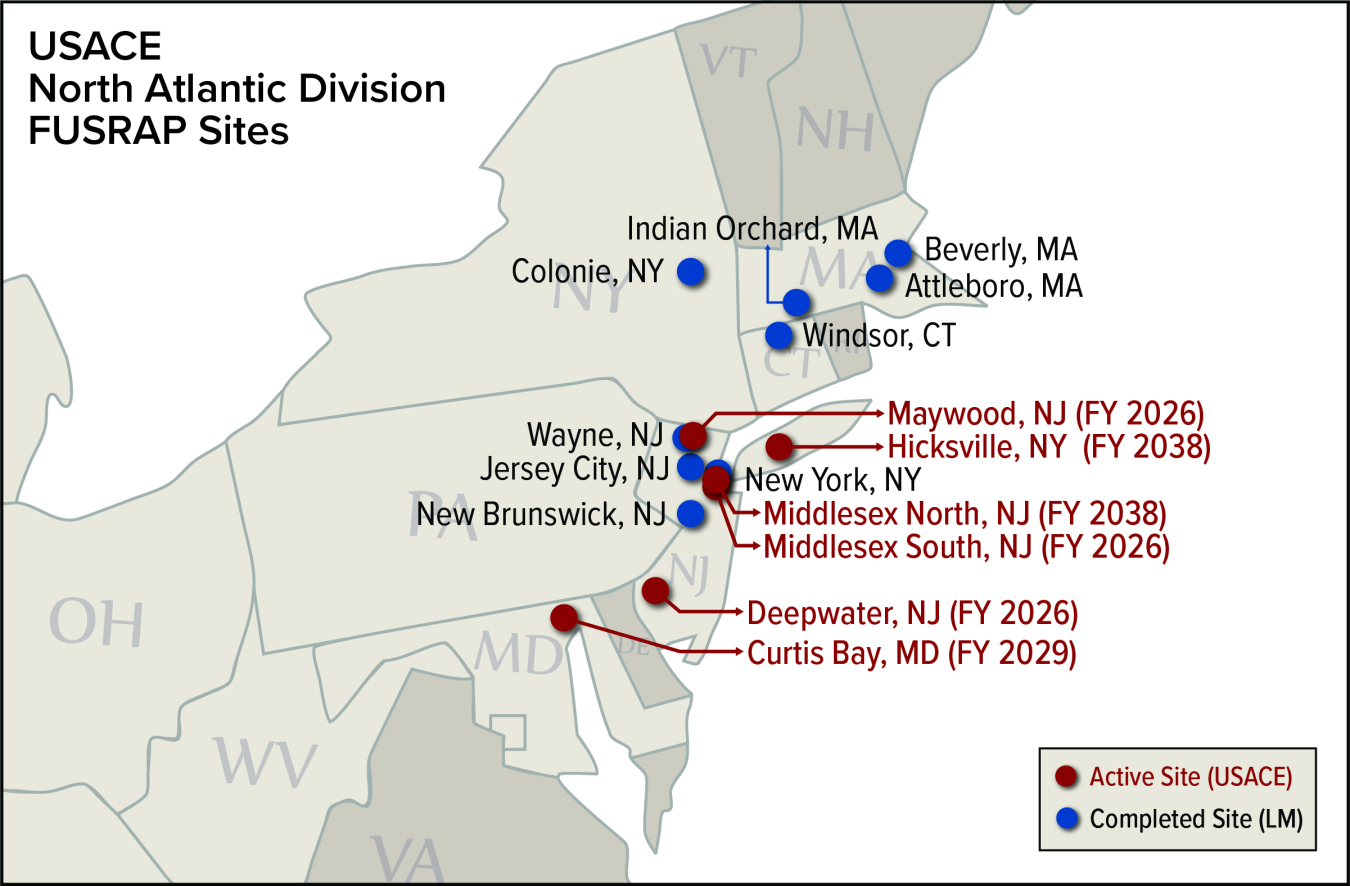USACE and LM take a virtual approach to the North Atlantic Division FUSRAP Sites Annual Tour.
August 27, 2020
Instead of piling into vans and hitting the road, more than 30 attendees from the U.S. Army Corps of Engineers (USACE) and U.S. Department of Energy (DOE) Office of Legacy Management (LM) logged into WebEx on June 9–11 for a virtual exploration of USACE North Atlantic Division (NAD) Formerly Utilized Sites Remedial Action Program (FUSRAP) sites.
FUSRAP was established in 1974 to identify and clean up sites that supported the Manhattan Project during World War II and the U.S. Atomic Energy Commission during the Cold War. In 1997, Congress transferred management of FUSRAP to the U.S. Army Corps of Engineers. USACE is responsible for remediating FUSRAP sites before transferring them to LM for long-term stewardship.
The annual tours strengthen the partnership between LM and USACE by helping to identify new opportunities to leverage each other’s strengths. Information sharing and collaboration ensure an efficient and cost-effective process for transferring sites between the two organizations.
The decision to go virtual this year was an easy one.
“There’s no doubt that meeting face to face on location is extremely valuable for gaining firsthand knowledge of sites,” said LM FUSRAP Site Manager Darina Castillo. “However, due to COVID-19, meeting online was the best way to protect the health of our staff and our FUSRAP communities.”
“It was the right thing to do,” agreed Comprehensive Environmental Response, Compensation, and Liability Act/Resource Conservation and Recovery Act/FUSRAP Team Lead Gwen Hooten. “Our core mission is to protect human health and the environment, and, in this case, that meant minimizing travel exposure through use of top-notch virtual technology.”
Leadership from both organizations attended this year’s tour, including LM Director Carmelo Melendez, USACE FUSRAP National Program Manager Nicki Fatherly, and USACE NAD Program Manager Justin Gottesman. LM FUSRAP site managers Darina Castillo and Cliff Carpenter led discussions on the previous year’s collaborations, site transition lessons learned, and life cycle budget assumptions for each site.
USACE Project Manager Jim Moore kicked off the virtual tour with a discussion of the Maywood, New Jersey, Site, which is currently in a construction phase. Excavation of contaminated soil continues per the Record of Decision (ROD), with less than 20,000 cubic yards of accessible soil in need of disposal.
USACE Project Manager Helen Edge gave a walking video tour of the Middlesex North, New Jersey, Site (Middlesex Municipal Landfill). The site is on schedule to produce a final Proposed Plan (PP) and ROD, which will determine the necessary remedial action for the site. Edge also presented on the Middlesex South, New Jersey, Site (Middlesex Sampling Plant). The main site soil is being remediated, and the remediation alternatives will be presented to the public in the PP later this summer.
Edge covered the Hicksville, New York, Site (Sylvania-Corning) as well. USACE is working to finalize the Remediation Investigation Report and is prepared to proceed to the Feasibility Study. Once a remedy has been decided, the transfer date will be determined.
The FUSRAP team virtually visited the Deepwater, New Jersey, Site (DuPont Chambers Works) in the USACE Philadelphia District. The site consists of a 700-acre chemical plant where DuPont began uranium operations in 1942. An estimated 50,000 cubic yards of contaminated material is on-site, requiring extensive coordination with the landowner and an on-site treatment plant. The USACE site team is utilizing dense environmental and spatial data, involving extensive modeling and visualization to show the site’s life cycle, monitor change over time, and improve decision-making at the site. This early investment in technology ensures that remediation is being performed in a cost-efficient manner.
USACE Project Manager Ivanna Goldsberry wrapped up the virtual tour with the Baltimore District’s Curtis Bay, Maryland Site (W.R. Grace). W.R. Grace conducted thorium-processing operations of monazite sands at the facility in the late 1950s under contract with the U.S. Atomic Energy Commission. Remediation activities are continuing and collaboration with the property owner will be pivotal when the site transfers to LM.
Over the three days of virtual tours of the NAD FUSRAP sites, USACE and LM demonstrated the importance of strong communication and close collaboration for mission success.
“Even in the virtual environment, we can all agree that these opportunities are invaluable to both of our organizations,” said Darina Castillo. “The videos and presentation materials that the Corps shared gave us better understanding of the sites and allows for better transition planning and long-term stewardship.”

The six North Atlantic Division FUSRAP Sites, with approximate transfer dates, can be seen here along with sites already in the LM portfolio.

